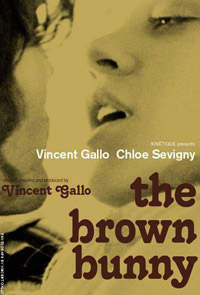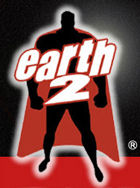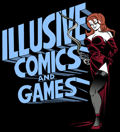|
The
Brown Bunny
The word “controversy” has pretty much gone
hand-in-hand with Vincent Gallo’s latest film, The
Brown Bunny, since its Cannes screening left its audience
in a shell-shocked state.
Much
has already been made of the reported boos, the critical
backlash, a press-fueled tiff and eventual reconciliation
between Gallo and film critic Roger Ebert, and the fact
that the film features a hardcore oral sex sequence in its
third act. It almost seems redundant to mention them, but
how does one ignore them?
At the
end of the day all that really matters is how the film holds
up on its own. In this case what we get is a profoundly
personal and deeply affecting film that engages its viewers
by referencing those moments of reflection, remorse, and
perseverance that we’ve all individually experienced.
The
plot centers on Bud Clay (Gallo), a motorcycle racer who
appears self-sufficient at the racetrack. We watch as Bud
competes in a race on his brown number 77 Honda in a very
sullen and withdrawn sequence shot entirely from a fan’s
perspective atop the bleacher seating, and after the race
he alone loads his equipment into his van and then departs
for California.
From
this opening sequence it becomes apparent that is a “man
without.” He is a man without a pit crew, and as the
film progresses it continues to reveal more and more ways
in which he is in isolation.
From
this point on, the film takes a slow approach to Bud’s
journey, and this is where it loses a lot of its audience
in the process. In likely homage to Monte Hellman’s
1971 cult film, Two-Lane Blacktop, the film is
about the journey, and about placing its viewers in that
van with Bud as it crawls from state to state.
Two-Lane
Blacktop focuses on the essence of travel and life
on the road as it details two very silent types, James Taylor
stars as the driver and Dennis Wilson is his mechanic, as
they move from one drag race in search of the next. In Bunny,
we watch as Bud travels from female encounter to female
encounter, all the while attempting to piece together his
past and why he behaves the way he does with the women he
meets on the road.
He at
first appears to be seeking out his next female relationship
when he approaches these women, but something is preventing
him from following through on these chance encounters. With
each new one we learn a little bit more about Bud and we
get a better view of what it is that is haunting him.
At one
point early on in the film, Bud visits an elderly couple,
parents to Daisy, the woman Bud loves. We learn from this
encounter that Daisy has not called her parents in some
time, and that Bud and Daisy have a house together in Los
Angeles. When asked if they’ve had kids yet, a note
of solemnity tinged with loss is evoked, implying that Daisy
may be the key to Bud’s behavior.
Clocking
in at a runtime of only 92 minutes, the film feels much
longer due to its somber pacing. To some, this could be
a bit trying, and others may argue that this is intentional
and therefore essential. I happen to agree with the latter.
The
film’s subtlety works on a tremendous level, offering
slight implications as clues and symbols throughout the
film. Gallo’s use of doorways in contrast to historical
conflict is significant, and a revelation surrounding Bud’s
roadside encounters is so subtle that when it becomes apparent
one nearly slaps himself for not noticing this connection
initially.
Fortunately
film as a medium is completely subjective, so everyone will
take something different from a film such as this. When
Bud reaches Los Angeles, he eventually encounters Daisy,
his lost love.
Their
encounter is one of rigid unease, a wealth of emotions buried
behind an attempt by Bud to remain stoic and unmoved while
Daisy pleads for his forgiveness. To reveal much more would
damage the essence of the film itself.
However,
the graphic nature of their final encounter is entirely
appropriate within the context of the film and the development
of Bud’s character. This is not an attempt at titillation
or cheap sensationalism.
The
fact that the “blow-job scene” has been so widely
publicized is a detriment to the film, and will likely lead
to countless eager adolescents seeking out a glimpse at
a hardcore scene involving Chloe Sevigny. What they will
be met with instead is an artful film about introspection
and soul searching, and this will likely cause frustration.
Even
Gallo himself calls attention to this on the film’s
posters and ads by including “Adults Only” on
nearly every poster. Of course, although the film includes
an “adults only” sequence, Gallo seems to be
requesting that only those willing to screen this film in
an adult manner be admitted.
Gallo’s
reputation also works against him here. The film opens with
a title card listing Gallo as the Writer, Editor, Producer,
and Director of the film. A quick cruise of the IMDB credit
listing for the film and you will see that he also stakes
claim over nearly every other aspect of the film as well.
This
is not meant to imply negativity towards Gallo in any way
whatsoever. This film is extremely personal and it’s
easy to understand why he would take such measures of control
over these aspects of the film. However, one can see where
many might interpret his ownership over the film as being
an act of pompous ego.
That
Gallo stars in the film and his character is the recipient
of the controversial sex act only adds fuel to the argument
that this film is nothing more than an exercise in self-indulgence.
In that regard, there is only one guarantee with The
Brown Bunny, and that is that the film is sure to polarize
audiences.
Those
willing to look past all of the controversy will find a
deeply engaging film that is ascetically resonant and rooted
in humanity from a filmmaker willing to go out on a limb
at all costs. In at least one opinion, it’s well worth
the journey.
Rating:

|






